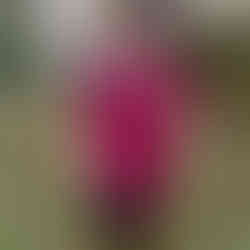
Walking around work, I noticed someone had the most adorable shirt on. It was a dolman-style top with points at the bottom, much like a handkerchief or shark bite hem. The main difference, that I noticed, was that the points were in the middle, instead of on the outer edges like I’ve seen a lot of ready-to-wear tops have. I knew I needed to recreate this look and the Dream Tee was just the way to do it!
Recreating this style is super easy, since it doesn’t require any extra math and all the changes are done with the help of a ruler. Instead of using a ruler, you could also use quilting guides and a rotary cutter. I used a basic ruler and scissors, to avoid pulling out my cutting mat.
I started by cutting the bottom edge first, since it made it easier for me to remember that I need to cut the bottom differently than I see the pattern piece. This hack works on both the dress and the tee style, but you may need a longer ruler for the dress style if you’re not using a quilting guide. I made a size 16 and only needed to cut about an inch free-handed where the middle point was to be. To cut the triangle piece, simply line the smaller edge of your ruler or guide to the outside corner of your pattern piece. On the standard pattern piece, this is where the bottom curves in a bit to get the more curved-hem look that the pattern traditionally has. The edge of my ruler is 1 ¾ inches, but you can make this longer if you want a more exaggerated outside corner, too. With a ruler, line the inner corner of the short end with the corner of the pattern piece. This will extend your pattern piece by the width of your ruler. Again, you can make this longer if you want this more exaggerated. If you are using a quilting guide, you can get the same effect by lining up the 1 ¾ (or longer) inch mark with the corner of the pattern and then using the length of your guide to create the rest of the angle.
Angle the ruler as much or as little as you want beyond the end of the pattern piece, at the fold. I did a 45 degree angle, giving me my desired pointy-ness. If the angle is too harsh at first, remember you can always make it less of an angle, but once cutting, you cannot add more. Finish cutting the rest of your pattern out and do the same for the other bodice piece. You can use your first piece to match the angle, just be careful not to cut through it!
Once you’ve completed cutting, sew your side seams, sleeves, etc as you normally would (check out the pattern tutorial if you’d like a refresher!). There’s really no changes here until we get to the hemming, which is the fun part. Now, I don’t have a fancy coverstitch machine and I am HORRIBLE with a double needle, so bear with me. I hem with a single needle and probably at too short of a stitch for a knit fabric, but it’s in my blood and my way of life. I like living on the edge, as they say.
To get the best point at the end, cut a little notch just at the tip of your point. I promise, this works. It does not take away from the beautiful pointy-ness and it makes it sew much easier. I cut a triangle about ¼ of an inch into my point. This notch made it easier to start my hemming without taking away too much of my allowance. Fold up your hem on either side of the notch. Make sure you press. If you are not sure how your fabric will react to the iron, use a pressing cloth or towel to help. If you’re not in a rush, sometimes I just pin my hem and press it in a book. The choice is yours, my friend.
Once you’ve pressed your hem, gotten your point to the crisp corner you’re looking for, and you feel confident in navigating the seams, HEM! Like I said, my hemming technique is a standard single needle with a (too-short) straight stitch. If you are using a single needle, make sure to pivot around the corner. With a double needle, once you get to the point stop, raise the needles, turn the fabric, and then keep going. This will help keep you from breaking your needles but also will help keeping the corner from bunching up.
For this hack, I used a light weight sweater knit similar to the alpaca knits that Amelia Lane has had recently. For my next one, I will be using a waffle knit and simply serging the hem instead of folding and hemming.











